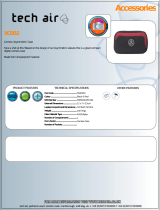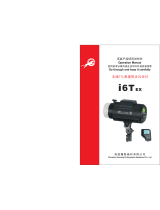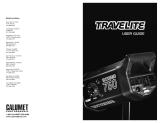
QUAD2400
QUAD2400 GENERATOR INSTRUCTIONS BWL-0350/1
BOWENS INTERNATIONAL LIMITED
355 Old Road
Clacton on Sea
Essex CO15 3RH UK
Tel: +44 (0)1255 422807
Fax: +44 (0)1255 436342
www.bowensinternational.com
QUAD
imaging power
BW-7620

Due to our policy of constant product improvement, Bowens International reserves the right to change equipment
specifications without notice.
Specifications
www.bowens.co.uk www.bowens.co.uk
Table of Contents
112
Description Page
Introduction and Safety Notes 3
Control Panel Guide 4 – 5
Flash and Modelling Function Overview 6 – 7
Triggering System 7
Getting Started 8
Warnings and Troubleshooting 9
Specifications 11
2
2 (1 per channel)
Manual Selection - Channel A = Symmetric
2 f-stops in one-stop increments
3 f-stops in
1
/3-stop increments on each channel
One LED numeric display per channel
±1% at maximum power
230V AC, 50/60Hz / 90 - 130V AC, 50/60Hz
Green Ready Indicator lights up at 100% charge.
Audio Ready Signal and Modelling Intermittent when selected.
15A thermal breakers for charge and modelling
6V
Switchable: On/Off
Switchable: On/Off
650w (max.) x 2
Off, Proportional, 100% or Automatic 100%
in either Continuous or Intermittent flash-indication mode.
QUADX Flash Head (BW7660)
281 x 184 x 336mm (362mm inc. handle)
2400w/s Channel A only or split 1200W-s Channel A + 1200W-s Channel B
37 to 2400w/s (6-stops)
Fast: <3 seconds (230V) <4 seconds (117V)
Slow: <5 seconds (230V) <6 seconds (117V)
640 (feet/100 ISO) with UV-coated tube
1/300 sec. at 2400W-s
1/1400 sec. at 600W-s
5600 K with UV-coated tube
9.5kg

Introduction
Safety Notes
310
DO NOT:
• Use in an environment where moisture or flammable vapor is likely to come in contact with the
pack or the flash heads.
• Plug or unplug flash heads without first switching power off.
• Restrict air vents while in use.
• Use a unit with damaged housing, moldings, flash tube or modelling lamp.
If the unit is dropped or damaged in any way, always have it checked out before using.
• Operate the unit without a safe grounded AC supply.
DO:
• Switch power off and disconnect from the supply before changing modelling bulb or flash tube.
• Observe the AC power supply requirements.
• Ensure that the flash head cable locking rings at the power pack or adapters are fully
locked before use.
• Avoid placing cables where they can be tripped over. Protect from heavy, sharp or hot objects,
which may cause damage and replace damaged cables immediately.
• Unplug the power pack from the electrical outlet when not in use.
• Remove the power cord by gripping the plug. NEVER pull the cord.
• Ensure that any extension cord used has a suitable current rating to prevent overheating.
NEVER use coiled extension cords.
• ALWAYS remove the flash head covers before using.
Dear Valued Customer,
Thank you for choosing the Bowens QUAD2400 professional flash system.
Accurate, ergonomic, powerful and simple to use, the QUAD2400 power pack was designed by
working closely with photographers to develop a flash that meets the standards demanded in
professional studios today.
Heads and accessories from the QUAD range can be used with the QUAD2400 power packs. For
details of all related products, please contact your local distributor, a list of which can be found at
www.bowensinternational.com.
In order to obtain the full benefit from your purchase, please take a few moments to familiarise
yourself with this user manual.
Thank you.
Bowens International Ltd.
QUAD2400
Number of Channels
Number of Head Sockets
Symmetric/Asymmetric
Master Power Control
Independent Channel Variators
Power Level Display
Flash Voltage Stabilization
Supply Voltage
Flash Ready Indication
Overload Protection
Sync Voltage (Max.)
Photocell
Audio Ready Signal
Modelling Lamps
Modelling Modes
Recommended Flash Head
Dimensions (l x w x h)
Stored Energy (Max.)
Flash Power Control Range
Typical Recycle Time
(Full Power)
Guide Number
(Full power, 50° Keylite, ISO 100)
Flash Duration (t=0.5)
(One Head, Max. Variator)
Flash Colour Temperature
Weight
www.bowens.co.uk www.bowens.co.uk

Control Panel Guide Warnings Signs and Troubleshooting
4 9
If the unit appears to have developed a problem, first establish that it is a genuine internal problem and
not a case of normal operation such as overheating. Carry out the following checks to eliminate any
external causes. If no obvious problem can be found and replacement of the modelling lamp, flash tube
or flash head fuse does not eliminate the problem, then it is likely that an internal problem has
developed. Always return the unit to an authorized service centre if a problem is suspected after these
checks. UNDER NO CIRCUMSTANCES SHOULD YOU ATTEMPT ANY REPAIR YOURSELF.
• Overheat Warning
The power pack is fitted with a thermostatically controlled fan, but under extreme conditions of use the
power pack may still overheat, even with the fan running. Flashing less frequently and/or using the
Slow Charge Mode will normally help prevent this from happening.
Overheat protection is provided to inhibit charging until the unit has cooled sufficiently to operate
normally. The Power Level Displays will flash “Overheat” warning while the overheat condition exists.
NOTE: The overheat condition remains until the power pack reaches a safe operating temperature or
the unit is turned off and allowed to cool.
• Control Panel Does Not Light Up
If the Control Panel does not light up when the unit is switched on, first check the AC power-cord
connections and check to make sure the AC outlet is working. Under exceptional conditions of use or
component failure, the Internal Fuse may blow. This is designed to protect the unit. Report the problem
to your local service agent. DO NOT ATTEMPT TO LOCATE AND REPLACE THE INTERNAL FUSE
YOURSELF.
• Control Panel Lights Up But Ready Indicator Does Not Light Up
If this happens, first confirm that the AC-line voltage is adequate and within the prescribed limits.
Confirm that the Flash Thermal Reset Button on the Rear Panel is pushed in. Under exceptional
conditions of use, this may trip. Switch the unit off, wait a minute, push the button in and then switch
power on again.
• Modelling Lamps Are Not Working
If all of the modelling lamps are not working, first check to see if the Modelling Thermal Reset Button
on the Rear Panel is out. If this is the case, DO NOT RESET IT until you have checked the head(s) for
blown bulbs and/or fuses.
• Power Pack Triggers Erratically
Check to see if the power pack is being triggered by another flash source by turning the photocell off.
Top Control Panel
Sync Sockets
Head
Socket ‘A’
Head
Socket ‘B’
Fast/Slow
Switch
(Under Handle)
Carry Handle
Channel A
Power Level
Display
Channel B
Power Level
Display
Overall Power
Selector
Modelling
Mode Selector
Channel A
Variator
Channel B
Variator
Audio Switch
and LED
Photocell
Switch and LED
Test Button and
Ready Indicator
Photocell
Window
www.bowens.co.uk www.bowens.co.uk

Getting Started Control Panel Guide
8 5
Before first using your power pack or after an extended storage period, it is recommended that the unit be
checked for basic operation as follows:
1. Remove the packaging and ensure that the unit is switched off.
2. Set up a flash head. Be sure the protective cap is removed and the modelling lamp is fitted and switched
on.
3. Plug the head into the socket of Channel A.
4. Set the Overall Power Selector to Symmetric/2400 and the Channel A Variator to Full.
5. Set the Modelling Mode Selector to Intermittent/Proportional.
6. Set Audio Switch to On, Photocell Switch to Off and Fast/Slow Switch to Slow.
7. Connect the power pack to a 230V AC, 50/60Hz outlet using the power cord.
8. Set the Power On/Off Switch to On. The unit will show “2400” on the Channel A display. The pack will now
charge to this setting.
9. Confirm after a few seconds that the Ready Indicator lights up, the Audio Ready Signal beeps and the
flash head’s Modelling Light is on at Full brightness.
10. Use the Test Button to discharge the set power into the head.
11. Confirm that the head flashes, the power pack recycles and Ready Indicator lights up.
12. Repeat steps 8 and 9 with the Overall Power Selector set to Symmetric/1200, Symmetric/600,
Asymmetric/1200, Asymmetric/600 and Asymmetric/300. Confirm that there is an appropriate change of
light output with each change of setting. Use a flash meter if possible.
13. Reduce the Channel A Variator setting to -3.0 and confirm that the Modelling Light has dimmed.
14. Confirm that the head flashes, the power pack recycles and Ready Indicator lights up.
15. Switch the power pack off. Plug the head into channel B.
16. Set the Overall Power Selector to Asymmetric/1200 and both Channel Variators to Full.
17. This time both numeric displays will show “1200.” The power pack will now charge to this setting.
18. Confirm after a few seconds that the Ready Indicator lights up, the Audio Ready Signal beeps, and the
flash head’s Modelling Light is on at Full brightness.
19. Use the Test Button to discharge the set power into the head.
20. Confirm that the head flashes, the power pack recycles and the Ready Indicator lights up.
21. Repeat steps 16 to 19 with the Overall Power Selector set to Asymmetric/600 and Asymmetric/300.
Confirm that there is an appropriate change of light output with each change of setting.
Use a flash meter if possible.
You are now ready to begin using the generator.
NOTES:
1 The QUAD2400 displays the power
available to each channel in watt-seconds on
the two red numeric Power Level Displays
marked Channel A and Channel B.
2 Beneath the Channel Power Level Displays
are the Channel Variators. These control the
individual power available from the Head
Sockets A and B in
1
/3 stop increments.
NOTE: The individual Channel Variators and
Power Level Displays are aligned with the
associated socket.
3 The Fast/Slow Switch, Overall Power
Selector and Modelling Mode Selector are
common to both channels.
Rear Panel
AC Inlet 230VAC 50/60Hz 16A
Flash Thermal Reset Button
Power On/Off Switch
Modelling Thermal Reset Button
The AC Inlet, On/Off Switch and Thermal Reset
Buttons are mounted on the rear panel.
NOTE: If the unit has been left unused for six months or predominantly used with low power settings,
it is recommended that the Power Level be increased to Maximum and the unit left switched on for
at least 30 minutes occasionally to help preserve the life of the capacitors.
www.bowens.co.uk www.bowens.co.uk

Function Overview Function Overview
Triggering System
6 7
Flash Power Control
The power pack is divided into two channels, A and B, and each is fitted with one head socket. An LED
display for each channel indicates the available power in watt/seconds available at the head fitted to that
channel.
A single Overall Power Selector reduces the pack’s total power by one or two f/stops and individual
Channel Variator controls reduce each channel’s power by a further three f/stops in
1
/3-stop steps. The
Overall Power Selector has settings for both Asymmetric (A/B) and Symmetric (A+B) modes.
The selected power in Asymmetric mode is available independently from each channel whether or not
any head is fitted in the other channel. The power available is controllable by using the appropriate
Channel Variator and the associated display.
The full selected power in Symmetric mode is only available from Channel A, providing that no head is
fitted in the Channel B socket. The total power available is shown on the Channel A Power Level
Display and is controllable by means of the Channel A Variator only.
In general, the Overall Power Selector should be set to the lowest setting and the Channel Variator(s)
set to the highest, consistent with the flash power and the distribution between heads required. This
method provides the shortest flash duration for a given power output.
Whenever the power levels are changed, the pack automatically dumps any excess energy. The Test
Button will flash while this is occurring. The time for the Ready Indicator to light up can be reduced by
using the Test Button to flash the pack.
Modelling Control
The Modelling Mode Selector provides a common control for the modelling lamps of all fitted heads.
Note that most heads are fitted with a modelling lamp On/Off Switch that overrides the control on the
power pack. As well as Off, the pack provides three modelling modes, each available with Intermittent
flash indication:
1. Off turns all lamps off.
2. Intermittent extinguishes the lamps when the pack is fired and turns them back on again when the
pack is 100% recycled and Ready Indicator lights up. This provides a visual indication that the pack
has been successfully triggered and has recycled.
3. Continuous turns the Intermittent mode off.
4. Proportional sets the lamp brightness in proportion to the appropriate Channel Variator setting.
5. MAX sets all lamps to full brightness.
6. Automatic 100% sets the modelling lamps of the head plugged into the channel with the highest flash
power setting to 100% and the modelling lamps of the head plugged into the other channel in
proportion to its variator setting.
HINT: The unit can be set to display power in terms of a decimal reading where 10.0 represents full
power. This display mode can be set by holding down the test button at switch on.
Test Button and Ready Indicator Light
The green Test Button is lit whenever the power pack reaches 100% charge and is ready to be
triggered. This light flashes when the pack is automatically dumping excess energy after a power-level
adjustment.
Press the Test Button to:
1. Trigger the power pack for test purposes whenever the Test Button is lit.
2. Dump excess energy quickly while the Test Button is flashing. This avoids having to wait a few
seconds for the pack to automatically dump energy.
Audio Indicator
An Audio Ready Signal is provided to beep when the generator is 100% recycled. Turn the Audio
Switch On with the rocker switch. The red LED lights up when the Audio is on.
Photocell
A Photocell is provided to trigger the power pack from another flash source or IR Trigger. Turn the
Photocell On with the rocker switch. The red LED lights up when the Photocell is on.
Fast/Slow Charge
The power pack has the facility to adjust the charging times. Turn the Fast/Slow Switch to Slow if:
1. Only a poor quality AC supply is available.
2. Several power packs are to share the same supply.
3. Fast recycling is not required.
Using the Slow setting whenever possible will prolong the life of the power supply.
The power pack may be triggered from the following sources:
1. An external sync source plugged into either of the Sync Sockets. This will trigger the power pack if
the Ready Indicator is lit. The Sync Socket line is nominally +5V and designed for low voltage
camera operation. These sockets may also be used with radio and IR triggers to provide a
synchronised trigger.
2. The Test Button will fire the power pack only if the unit is charged and the Ready Indicator is either lit
or flashing.
3. When the Photocell is switched on, the power pack will trigger in response to an external flash of
light, if the Ready Indicator is lit. For best results, be sure that the red Photocell window is clearly
exposed to the triggering light source.
www.bowens.co.uk www.bowens.co.uk
-
 1
1
-
 2
2
-
 3
3
-
 4
4
-
 5
5
-
 6
6
Bowens BW-7620 User manual
- Type
- User manual
- This manual is also suitable for
Ask a question and I''ll find the answer in the document
Finding information in a document is now easier with AI
Related papers
-
Bowens Portable Generator QUAD2400 User manual
-
Bowens EQUIPE 2400 Pack Operating Instructions Manual
-
Bowens BW7635 User manual
-
Bowens DUO 4800 PACK Operating Instructions Manual
-
Bowens Portable Generator QuadX 3000 User manual
-
Bowens EQUIPE 2400 Pack Operating Instrctions
-
Bowens QUAD 2400 User manual
-
Bowens BW-7600 Operating Instructions Manual
-
Bowens BW-1900 Datasheet
-
Bowens Camera Flash BWL-0335/2 User manual
Other documents
-
 Tech air TAXC002 Datasheet
Tech air TAXC002 Datasheet
-
 Cononmark i6TEX Operating instructions
Cononmark i6TEX Operating instructions
-
Elinchrom Classic Power Packs 1500 - 3000 - 6000 User manual
-
Elinchrom Digital 3000 User manual
-
Elinchrom 3000 User manual
-
Elinchrom 1000 User manual
-
Elinchrom 300RX User manual
-
Profoto Pro-B2 User manual
-
Elinchrom Ranger RX Speed User manual
-
 Calumet CE1105 User manual
Calumet CE1105 User manual








